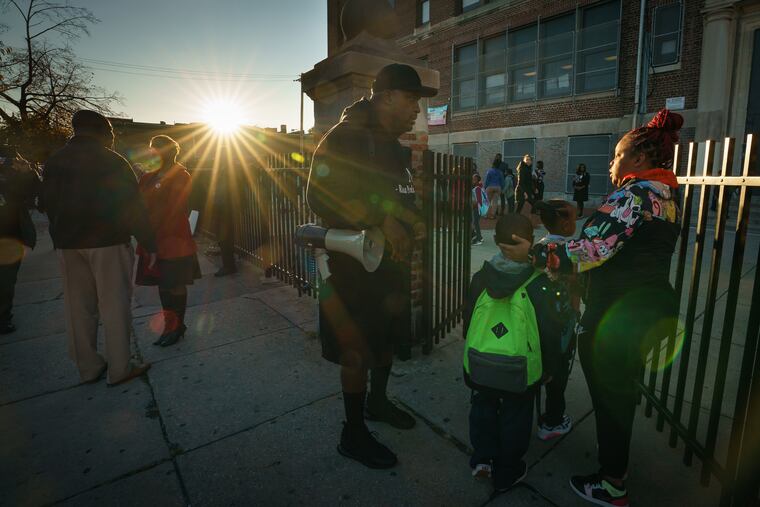‘It’s not safe for kids to be in this school’: North Philadelphia parents demand answers about asbestos
“We’re going to make people accountable for exposing our children to asbestos,” Councilwoman Cindy Bass said.

Jesse Stanton kept his two children at home Monday. Until there are answers from the Philadelphia School District, he said, he doesn’t want to risk his children being exposed to asbestos at Thomas M. Peirce Elementary.
“My kids said, ‘Why can’t we go to school?’ and I said, ‘I don’t want you to get cancer 10, 20 years from now,’” Stanton said outside the North Philadelphia schoolyard.
Stanton stood with parents from around the city to demand answers from the district, which they feel waited too long to address asbestos found at the school.
The Philadelphia Federation of Teachers’ environmental expert flagged damaged asbestos at Peirce in mid-September. The school system did not send a crew to examine Peirce for asbestos until The Inquirer began asking questions last week. District officials were already under fire for their mishandling of asbestos contamination during construction at the shared Benjamin Franklin High School-Science Leadership Academy campus, resulting in the abrupt closure of the building and the relocation of nearly 1,000 students.
A district spokesperson said Monday afternoon that the district attempts to follow up on asbestos reports within 72 hours, but that Peirce was not addressed more quickly because “we did not have the capacity to do so for this location” given the involved projects at several other schools.
After learning about the asbestos from a reporter, Peirce parent Antoine Little began organizing politicians, parents, and PFT president Jerry Jordan “to condemn and protest” the district Monday.
“Enough is enough,” said Little, who has three children at Peirce, a K-6 school at 23rd and Cambria Streets with 437 students. “I know I don’t want my children exposed to asbestos.”
He and others said they felt the district has handled high-profile cases at schools with lower concentrations of poor children differently than they handled the Peirce case. At Meredith Elementary, a high-performing school in South Philadelphia, officials moved swiftly to remediate hazards after a longtime teacher was diagnosed with mesothelioma, a cancer linked to asbestos exposure. The district also removed children from the Ben Franklin High building once parents from Franklin and SLA, which share the space, pushed for it. SLA is an acclaimed magnet school.
Meredith parents came to the Peirce protest Monday to show their solidarity.
“We feel like it’s important to give voice to the Peirce parents,” said Heather Atkinson, whose child attended Meredith until this year. “Things were handled differently at Meredith, and we know why."
The difference, Atkinson said, is that “poor black children” attend Peirce and Meredith enrolls mostly white children who do not live in poverty.
“I wanted to make sure that Peirce parents get a seat at the table,” said Caroline Thorn, a Meredith parent and School Advisory Council member.
Three City Council members also said they thought the Peirce environmental situation was mishandled.
“We’re going to make people accountable for exposing our children to asbestos,” Councilwoman Cindy Bass said.
“We’re here for the community members of T.M. Peirce, who deserve so much more," said Councilwoman Helen Gym. “These are our children, and they don’t deserve to be poisoned.”
Last Thursday, the district sent a third-party asbestos inspector from Vertex, an environmental firm in Delaware County, to look at potential hot spots that the PFT first pointed out in September. Jerry Roseman, the PFT’s environmental scientist, had concerns about an area in the gym, where he saw water stains and cracks in the wrapping around the asbestos pipe insulation. Peirce’s physical education teacher also told Roseman that children often struck the pipe with basketballs, causing debris to fall to the ground.
The Vertex inspector found cracking and exposed asbestos-containing insulation on pipes in Peirce’s gym, kitchen, and food service area in the hallway, and in lunchroom areas, according to the Oct. 24 Vertex report.
Environmental crews spent this past weekend at Peirce either removing or encapsulating asbestos material in seven locations, including the main gym and a second gym space where workers patched two small sections of pipe insulation.
In a letter to parents on Oct. 25, Danielle Floyd, the district’s chief operating officer, wrote that the district plans to close the gym and remove all the asbestos pipe insulation as a “proactive” measure since it’s a high-activity space. The district has to work out a time frame with Peirce’s principal for abatement work, noting that the children will need an alternative space for physical education classes, Floyd wrote.
Floyd, in that letter, wrote that “there is no damaged asbestos containing material in the gymnasium.” She noted, however, that the district’s inspection did find “damage” to asbestos pipe insulation in a basement hallway where food is prepared and served to students.
Roseman said he disagreed with Floyd’s characterization of the conditions in the gym.
“This really starts to sound just like politics,” Roseman said. “There are many schools with asbestos in which the material is in very good condition, intact, no cracks, no open ends, no water damage. That’s not the case at T.M. Peirce, and so T.M. Peirce needs urgent attention. This school — the condition was brought to the attention of the district almost six weeks ago. It’s too long for work not to have been done at T.M. Peirce.”
District officials have said that Peirce will eventually get a new building, “a modern learning environment aligned to 21st-century instructional practices and skills.” No timetable or price tag has yet been shared.
After the protest, some Peirce parents stood outside the schoolyard, sharing worries.
“We have kids with asthma, sick kids in this school,” said Tamitra Foreman, who has one child at the school. “Is it safe for kids to be in this school? It’s not.”
Staff writer Wendy Ruderman contributed to this article.